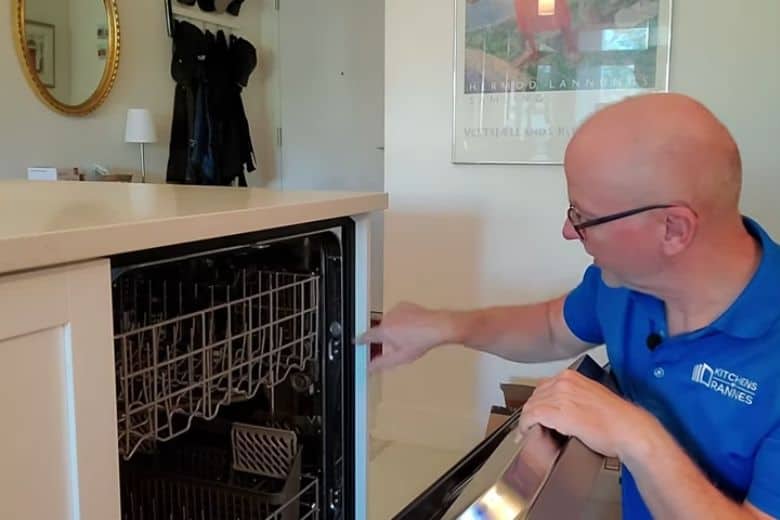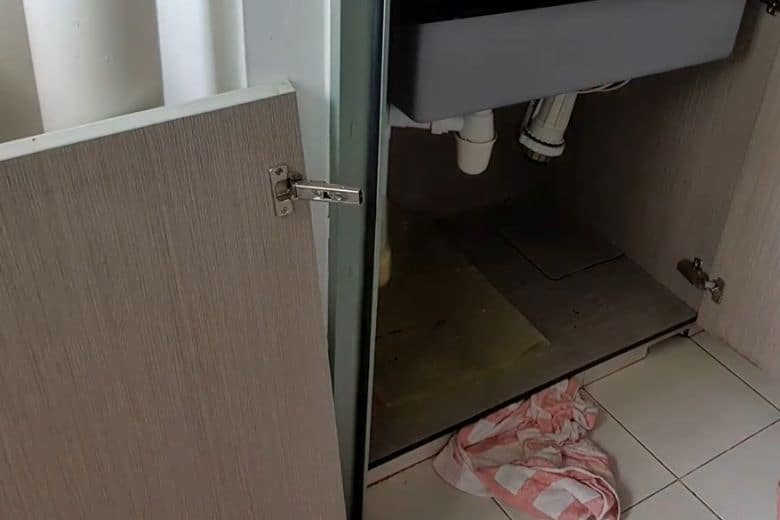When it comes to installing a dishwasher in your kitchen. One of the common questions that arises is, “should dishwasher be flush with cabinets?” Since you can only imagine a modern kitchen layout with the presence of a dishwasher.
Consequently, it is mandatory to place the dishwasher accurately. Because proper installation of a dishwasher has a significant impact on both the aesthetics and functionality of your kitchen.
With that said, today, we will explore the benefits and drawbacks of dishwasher placements. Besides, we will provide valuable insights to help you make an informed decision. Therefore, we included step-by-step guidelines, potential challenges, and maintenance tips to help you in your way.
Let’s get started!
What Does It Mean for a Dishwasher to be Flush with Cabinets?
First, Let’s clarify what it means for a dishwasher to flush with the cabinets. Well, when a dishwasher is flush with the surrounding cabinetry, the front of the dishwasher aligns perfectly with the cabinet doors. It creates a seamless and integrated look. In other words, the dishwasher is concealed and blends seamlessly with your kitchen design.
Now move forward to know the benefits and downsides of such dishwasher placement.
Benefits Having a Dishwasher Flush with Cabinets
1. Visual Continuity:
One of the main advantages of having a dishwasher flush with your cabinets is its aesthetic appeal. The flush placement ensures that the dishwasher does not disrupt the visual flow of the cabinetry. Therefore, it gives a cohesive and unified appearance.
These settings will be particularly beneficial if you have a modern or minimalist kitchen design. Because there a clean line and a seamless appearance are mostly desired.
2. Space Optimization:
Another benefit of having a flush dishwasher is it allows for better space optimization in your kitchen. By eliminating any gaps or protrusions, you can maximize the available space. Accordingly, it can ensure a more efficient workflow. It will be especially valuable in smaller kitchens, where every inch count.
3. Easy Cleaning:
With the dishwasher flush with the cabinets, there are no awkward gaps or hard-to-reach areas. It simplifies the cleaning process and prevents debris accumulation. Wipe down the front of the dishwasher, and your kitchen will maintain its pristine appearance.
Drawbacks of Having a Dishwasher Flush with Cabinets
1. Installation Challenges:
While the seamless look of a flush dishwasher is desirable. But the installation process can be more complex compared to a standard installation. Achieving a perfect alignment requires precise measurements and careful adjustments.
In that case, you might need to hire a professional installer. A person who has experience in integrating dishwashers into cabinetry to ensure a proper fit.
2. Limited Flexibility:
When a dishwasher is flush with the cabinets, it creates a few limitations. Firstly, removing or replacing the unit in the future may be challenging without affecting the surrounding cabinetry. Secondly, sometimes it becomes difficult to access certain controls or buttons on the dishwasher’s front panel.
Eventually, you must open the cabinet door above the dishwasher or reach around the side to adjust. At the same time, this may be a manageable inconvenience for most people. But it’s worth considering if ease of use is your top priority.
3. Potential Maintenance Issues:
Sometimes, having a dishwasher flush with cabinets can lead to maintenance challenges. If a problem arises with the dishwasher, accessing the inner components may require removing it from its integrated position. It can be time-consuming and complicated compared to a standard installation.
However, it’s worth noting that modern dishwashers are designed with serviceability in mind. So, it makes it easier to address potential issues.
Considerations Factor for Dishwasher Flush Installation
We have included possible pros and cons of dishwasher placement in the cabinet. Even if you want to install it, you must ensure a few things for a successful flush dishwasher installation.
1. Cabinet Height and Depth
The height and depth of the cabinets play a crucial role in achieving a flush installation. Ensure that the dishwasher dimensions align with the available cabinet space. Taking accurate measurements beforehand can help avoid any discrepancies during installation.
2. Adjustable Legs and Toe Kick
Many dishwashers come with adjustable legs to accommodate variations in cabinet height. These adjustable legs allow for fine-tuning the height to achieve seamless integration. Additionally, consider the toe kick space under the cabinets. It is important to ensure the dishwasher fits snugly without any obstructions.
3. Door Clearance
To ensure proper door clearance, measure the space between the dishwasher and the surrounding cabinets. The dishwasher door should have enough room to open fully without hitting adjacent cabinets or obstacles. Proper door clearance is vital for the convenient loading and unloading of dishes.
4. Integration with Other Appliances
Assessing the dishwasher’s integration with kitchen appliances before opting for flush installation is compulsory. Ensure that the dishwasher’s positioned and alignment with nearby devices. Examine that the refrigerators or ovens do not hinder their functionality or create an imbalance in the kitchen design.
Remember, proper appliance placement affects the kitchen layout’s harmony and functionality.
5. Overall Kitchen Style and Theme
The style and theme of your kitchen should be a key consideration when deciding on a flush dishwasher. Evaluate whether a seamless integration aligns with your kitchen’s desired aesthetic and design scheme. At the same time, a flush dishwasher offers a clean and modern look. But it may only be suitable for some kitchen styles.
Traditional or eclectic kitchens, for instance, may benefit from a more distinctive dishwasher design that stands out as a statement piece.
Steps to Achieve a Flush Installation
Now that we have covered the considerations. Now it is time to explore the step-by-step guidelines to achieve a flush installation for your dishwasher.
Step 1: Measure and Adjust Cabinet Height
Begin by measuring the height and depth of the cabinets. Besides, also ensure compatibility with the dishwasher’s dimensions. If necessary, adjust the cabinet height. Here you can use the adjustable legs to align perfectly with the dishwasher.
Step 2: Level the Dishwasher
Use a level to ensure the dishwasher is perfectly level, front-to-back and side-to-side. Adjust the legs accordingly until the dishwasher is level. A level dishwasher provides proper drainage and optimal performance.
Step 3: Secure the Dishwasher in Place
Once the dishwasher is level, secure it in place using screws or brackets provided by the manufacturer. Follow the installation instructions carefully to ensure the dishwasher is securely fastened to the cabinets.
Step 4: Connect Electrical and Plumbing
If necessary, hire a licensed electrician and plumber to handle the electrical and plumbing connections. Ensure all connections are made following local codes and regulations. Double-check the links to ensure they are secure and properly aligned.
Potential Challenges and Solutions
While achieving a flush dishwasher installation is generally straightforward. Apart from that, some challenges may arise. Here are a few potential challenges and their corresponding solutions.
- Limited Cabinet Space: In kitchens with limited cabinet space, achieving a flush installation might take a lot of work. Consider consulting with a professional kitchen designer or contractor to explore alternative solutions that maximize space utilization.
- Custom Cabinet Design: If you have custom cabinetry, working closely with the cabinet manufacturer or installer is essential. It helps you to ensure the dishwasher is integrated seamlessly. Custom solutions may be required to accommodate specific design requirements.
- Retrofitting Existing Cabinets: Retrofitting cabinets to accommodate a flush dishwasher installation might be necessary for existing kitchens. This process can involve adjustments to the cabinet structure. Moreover, it may require the assistance of a professional cabinet installer.
Maintenance and Cleaning Tips
Proper maintenance and regular cleaning can extend the lifespan of your dishwasher. Once more, ensure its optimal performance. Follow these tips to keep your dishwasher in excellent condition.
- Clean the dishwasher’s interior, including racks and spray arms, to remove debris and food particles.
- Regularly check and clean the filter to prevent clogs and maintain water flow.
- Wipe down the exterior with a soft cloth and mild detergent to remove fingerprints, smudges, and stains.
- Periodically clean the dishwasher’s interior, focusing on hard-to-reach areas using a dishwasher-safe cleaner.
- Follow the manufacturer’s recommendations to clean or replace the filters.
Frequently Asked Questions
Can any dishwasher be installed flush with cabinets?
Answer: Most dishwashers can be installed flush with cabinets. In that case, you must check the manufacturer’s guidelines and specifications to ensure compatibility.
Can I retrofit my existing dishwasher to flush with my cabinets?
Answer: Retrofitting an existing dishwasher to achieve a flush installation can be challenging. It may require modifications to the cabinets or countertop, which can be complex and costly. It’s best to consult with a professional to assess the feasibility of such a retrofit.
What is the standard gap between a dishwasher and a cabinet?
Answer: The recommended gap between a dishwasher and cabinets is typically around 1/8 to 1/4 inch. It allows for proper ventilation and prevents potential damage caused by heat transfer from the dishwasher.
Can a dishwasher be installed in any cabinet configuration?
Answer: Dishwasher installation can be adapted to various cabinet configurations. However, it’s crucial to consider your chosen dishwasher model’s specific requirements and consult a professional installer. They can help you determine the feasibility of installation based on your kitchen’s layout.
How can I ensure proper door clearance?
Answer: Measure the space between the dishwasher and surrounding cabinets to ensure adequate door clearance for convenient loading and unloading of dishes.
Are there any alternatives to a flush dishwasher installation?
Answer: If achieving a flush installation poses challenges or limitations, you can consider other options, such as panel-ready dishwashers or using decorative panels to conceal the dishwasher’s front. These alternatives can provide a visually appealing look while allowing more flexibility in design.
Do I need to hire a professional for installation?
Answer: While it is possible to install a dishwasher yourself, hiring a professional can ensure proper installation and minimize the risk of errors.
Conclusion
When it comes to the question, “should dishwasher be flush with cabinets?” the answer ultimately depends on your preferences and the specific characteristics of your kitchen. Hopefully, you already know all the possible pros and cons of a flush dishwasher. Although a flush dishwasher can enhance the visual appeal of your kitchen, offer easy maintenance, and optimize space utilization. However, it may involve installation challenges and limit design flexibility.
Remember, the perfect dishwasher placement should enhance the visual appeal of your kitchen and improve its usability and efficiency. Take the time to evaluate your specific needs and consult with professionals to create a kitchen design that surpasses expectations.
Paul Newman is a blogger who writes about plumbing and home improvement. Over the past 20 years, I have worked as a plumber. My passion is to share my knowledge and experience with others to improve their homes.




